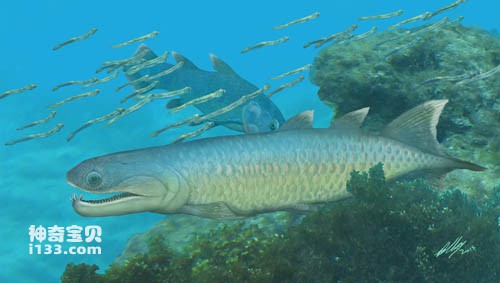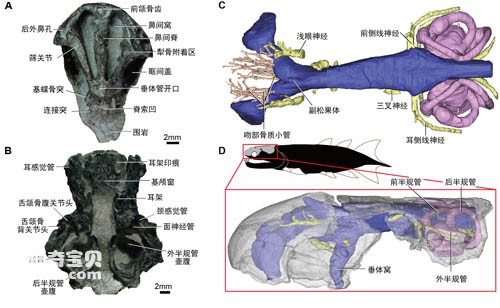On June 3, 2016, the American magazine "Science Advances" published online the latest research results of Lu Jing and others from Zhu Min's research group at the Institute of Vertebrate Paleontology and Paleoanthropology, Chinese Academy of Sciences. With the help of high-precision CT scanning technology, they conducted a detailed study of the fine brain cavity structure of the 410-million-year-old predatory fish Incisorus, revealing that the Incisorus had both the mosaic characteristics of the stem group and the crown group of lobe-finned fishes, and began to Unravel the mysteries of the early evolutionary stages of lobe-finned fishes.
Bony fishes are the backbone of vertebrate evolution. They are divided into two major branches: lobe-finned fishes and ray-finned fishes. They compete for dominance of the earth's waters. Today, the only lobe-finned fishes left in the water are lungfish and coelacanth, surviving in the shadow of a thriving and diverse array of ray-finned fishes. However, in the "Age of Fishes" during the Silurian-Devonian Period, lobe-finned fishes were overwhelmingly dominant. They differentiated into various forms along many directions, and emerged in the late 1960s about 380 million years ago. The Devonian landed on land and evolved four-legged animals, including humans.
Lobe-finned fishes began to develop explosively in the Early Devonian about 400 million years ago. This era divided the entire evolutionary history of lobe-finned fishes into two completely different stages. The lobe-finned fishes before this were classified into the lobe-finned fish group, represented by the dream ghost fish and the spotted fish. Their shapes were very primitive and they did not even develop typical lobe fins. Their fins were similar to those of ray-finned fishes. Classes are not much different. After that, large groups of lobe-finned fishes such as the familiar lungfish, coelacanths and tetrapods (the direct ancestors of land vertebrates) evolved one after another. They are usually collectively called the crown group of lobe-finned fishes or Modern lobe-finned fish.
During the great development of modern lobe-finned fishes in the Early Devonian, another group appeared. Although it could not compare with other large groups in terms of survival time, prosperity and even popularity, it evolved into the most ferocious fish of that era. Predators, these are Onychodonts.
This is a group of mysterious fish. Their entire evolutionary history is limited to the 60 million years of the Devonian period. There are only six genera of claw-toothed fish currently known, and most of the fossils are fragmented. In most cases, Only the long, curved, terrifying teeth that resemble the claws of raptors scattered among the rock formations mark the presence of these predators. It wasn't until the discovery of relatively complete claw-toothed fish fossils in Australia in the second half of the 20th century that we had a complete understanding of this type of fish.
Fossils show that claw-toothed fish had strong shoulders, and various parts of the skull could expand to facilitate subduing and swallowing large animals. Their iconic huge fangs are arranged in two wheel-shaped clusters at the front of the lower jaw, called "tooth whorls". When the mouth is closed, they are retracted into a deep socket like a sheath on the top of the mouth. These terrifying teeth can pierce the body of prey like harpoons, making it impossible for them to escape. Inside a claw-toothed fish about 60cm long, a 30cm-long placoderm remains was found. All evidence points to a ferocious, efficient aquatic "killer" adapted to ambush large prey.
In addition to the terrifying predatory structures, researchers have other good reasons to pay close attention to these mysterious "killers". Onychodont fishes are a mixture of the characteristics of lobe-finned fish groups, typical characteristics of modern lobe-finned fishes, and unique characteristics evolved by themselves. Sorting out the "tangle" of characteristics is crucial to determining the taxonomic status of onychodont fishes. , it is of great significance to trace the early evolution of modern lobe-finned fishes.
Usually, the complex and delicate structure of fish brains can provide the greatest amount of morphological information to help sort out this "mess". However, although the claw-toothed fish discovered in Australia is quite complete, the important brain part has not been preserved. Due to the lack of this part of information, the study of claw-toothed fish has fallen into a situation where it is difficult to make a meal without rice.
The discovery of fossils from Yunnan, my country, provides new opportunities to solve the above problems. East Yunnan in the Early Devonian was the "cradle" of the evolution of lobe-finned fishes and even the entire bony fish. The earliest known representatives of almost all large groups of primitive bony fishes were found here, including the oldest claws. Toothfish Qingmenodus yui.
So far, only the head skeleton of the incisor fish has been discovered. When it was alive 410 million years ago, its total length was about 15cm. The iconic features of claw-toothed fish such as tooth spirals indicate that although it has a small body, it is also a ferocious predator. What’s even more exciting is that it preserves a set of important cranial morphological information that is missing in Australian claw-toothed fish fossils, such as the brain cavity, inner ear, nerves and vascular pathways. The early evolutionary history of finned fishes adds an important piece of evidence.
High-precision CT tomography and digital three-dimensional reconstruction technology make it possible to study the brain structure of the incisor fish in detail. These new techniques allow researchers to discover previously unseen fine structures deep inside fossils. There is a series of bony branched tubules in the snout of the incisor fish. This structure has only been found in lungfish in the past. It is probably related to some special sensory organ. This may be why the claw tooth fish became Another tip for an effective water killer.
The more unexpected result is that the inner ear and brain cavity structure of the incisor fish actually have many similarities with the coelacanth fish. This new evidence suggests that claw-toothed fishes and coelacanths are closely related. It can be said that not long after the coelacanth fish appeared, a branch branched off and developed in the direction of being highly adapted to predatory life, thus evolving into claw-toothed fish.
Research also shows that the brain structure of the incisor fish retains many original characteristics, especially the features that were considered unique to claw-toothed fish in the past. In fact, they are also ancient characteristics of primitive lobe-finned fish, which makes claw-toothed fish become The key link connecting the stem group and the crown group of lobe-finned fishes more clearly shows how modern lobe-finned fishes, the fish-shaped ancestors of humans that once dominated the earth's waters in the "Fish Age", evolved.
This research was supported by the National Natural Science Foundation of China and the 973 Project of the Ministry of Science and Technology.

Figure 1 Ecological restoration map of Incisorus (drawn by Brian Choo).

Figure 2 Photograph of the brain of the fish Qing incisor and reconstruction of the brain cavity. A, The ventral surface of the brain in the ethmoid part; B, The ventral surface of the otoccipital area; C, The ventral surface of the brain cavity has been restored; D, The left side of the brain cavity has been restored, and the translucent shell represents the brain. II-X indicates the 2nd to 10th pairs of cranial nerve canals (photo provided by Lu Jing).

Figure 3 Schematic diagram comparing the brain cavities of various major groups of teleost fishes in the Devonian period (photo provided by Lu Jing)
animal tags: Devonian
We created this article in conjunction with AI technology, then made sure it was fact-checked and edited by a Animals Top editor.